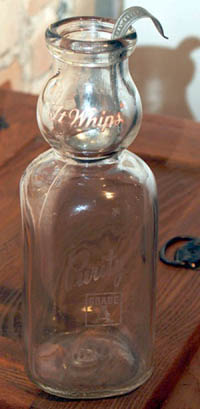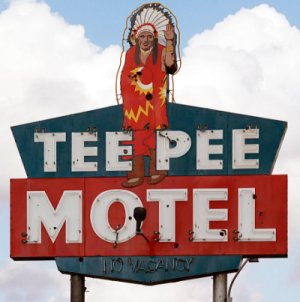Forgetting and Remembering
Today, we remember what we'd forgotten. The University of Houston's College of Engineering presents this series about the machines that make our civilization run, and the people whose ingenuity created them.
Yesterday, we went to see the new Museum of 20th-Century Technology down in Wharton, Texas. And I was reminded, as I so often am, of how the past fades -- like a car driving away in the fog.
That lesson began on the way into town. Old highway 59 passes the Teepee Motel. This had been roadside architecture of the 1940s, falling into ruin. But now we find it resurrected -- its wigwam units are rebuilt, fitted with TVs and Texas Star quilts. Some developer was unwilling to see this piece of the past go gentle into good night. And the Teepee Motel is an odd portent of what we'll find when we reach the museum itself.
There, we're greeted by Art and Sharon Schulze, who built it from the loaves and fishes of many people's lives. We catch a hint of what's coming right in front. There's a 1976 Burt Rutan home-built airplane -- the two-seat VerieZe.It's a canard pusher design with elevators in front and wings swept back into vertical rudders at each tip. Rutan's radical airplanes are now making suborbital space flights, and here is how all that began.
Schulze, who does electrical health care engineering, has a neat collection of quack medical devices -- like an electric shock machine to cure anything from asthma to cancer. And nowhere have I seen such an array of primitive radio and TV. As we trace the metamorphoses of radio tubes from the '20s to the '40s, we realize that a tube is not just a tube. My mother had been a radio singer in the 1920s, but only now do I see the sets that once carried her voice into homes through their great cornucopia-shaped speakers.
 The past does get away from us. That's why childhood resurfaces here with such a jolt. I'd forgotten toasters whose sides you lowered to insert the bread. Or milk-bottles with a small bulbous section on top to isolate the whipping cream that rose from unhomogenized milk -- and the tiny ladle for collecting the cream.
The past does get away from us. That's why childhood resurfaces here with such a jolt. I'd forgotten toasters whose sides you lowered to insert the bread. Or milk-bottles with a small bulbous section on top to isolate the whipping cream that rose from unhomogenized milk -- and the tiny ladle for collecting the cream.
I'd forgotten the metal pants stretchers, that we fit into freshly washed trousers to give them a crease. Here's my mother's washing machine and our first electric refrigerator. There's also a primitive cylindrical dishwasher. My mother would not take the bait on that one, despite three-color Saturday Evening Post ads that made it look so perfect.
On the way out, I take a last look at Farmer Grawunder's ornithopter. Grawunder held a 1942 patent on this leftover from the 1890s. He assembled his pedaled, flapping-wing-assisted glider from the flotsam of farm life. Then he carefully cut plywood feathers for the trailing edges of two tandem wings.
It is a loving reminder of how, time and again, imagination out-runs common sense. A thousand inventions leave two or three things that we actually use in their wake. That's what this museum is really about. It reveals the texture of the process by which civilizations rise upon a whirl of passionate individual ideas.
I'm John Lienhard, at the University of Houston, where we're interested in the way inventive minds work.
For pictures, be sure to click on the many links above. (All photos by JHL.)
The 20th Century Technology Museum has moved since I recorded this episode in 2006. It is presently located in the Wharton County Historical Museum, 3615 N. Richmond Rd. Exit I-59, north of Wharton, on Highway 60 -- aka Richmond Dr. Continue 1-3/4 miles. The Museum is on the Right. Tel. 979-282-8810 My thanks to Art and Sharon Schulze for their hospitality and counsel. Details at: http://www.20thcenturytech.com/
The resurrected Teepee Motel & RV Park is located at 4098 N. Highway 59, Wharton TX. It was originally built in 1942, and it ap-peared as a set in the original movie Lolita.
For more on the epoch of the early 20th century, see, J. H. Lienhard, Inventing Modern: Growing up with X-Rays, Skyscrapers, and Tailfins. (New York: Oxford University Press, 2003).

